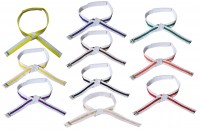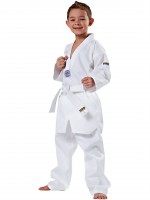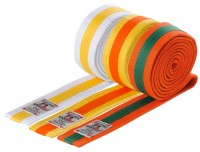Taekwondo – Speed and Dynamics in Perfection
Like so many martial arts Taekwondo also stems from Asia, more exactly from Korea. The concept is composed of the syllables Tae (for foot technology), Kwon (for hand technology) and Do (for way).
At first sight, Taekwondo possesses many parallels to other Asian combat sports; however, taking a closer look reveals some striking differences after all. In comparison with karate for example, the foot techniques dominate considerably here; in addition, Taekwondo is strongly designed to favour dynamics and speed of all movements. So this is an active combat sport, not a pure self-defence technique.
Similar to Judo, Taekwondo also was not developed before the 20th century, more exactly said, in the fifties. The Korean general Choi Hong is considered to be the inventor of this combat sport; Shotokan Karate having formed the base for it.
In the course of the years and decades, different styles were worked out in Taekwondo, which are described as disciplines today. Please find a short overview here:
The Grade School
At first the individual techniques are rehearsed without a real opponent. Permanent repetitions serve to practise automatisms in order to avoid having to think about the suitable technique as reaction to an attack during the fight anymore.
Executing Predefined Patterns
The exercises rehearsed in grade school are taken to a firm form now, i.e. they are executed in a predefined order. This happens without a real opponent as well.
The one-step Fight
Here, a real opponent is being used for the first time. The exercises rehearsed in grade school and in patterns are now acted out and applied in a practice fight with the opponent.
Man to Man
This is an exercise fight which is staged with an opponent. However, any touching is largely avoided in this fight; so this is also about using the well-rehearsed techniques in the correct order.
Competition
Now it is going into the thick of things; the techniques learned are used in a real fight against the opponent. Under the Taekwondo regulations, there are light, semi and full contact fights.
In addition to these basic exercises and fighting types, additional exercise and fight techniques come to use in Taekwondo:
Self-Defence
Complementing the attack techniques, there are special self-defence exercises aimed at fending off one or several armed or unarmed opponents.
Gymnastics
The exercises in this regard serve to render the body more elastically and more supple in order to be able to use the self-defence and fighting techniques with the greatest possible effect.
Breaking Test
In a breaking-test, platter, stones, brick etc. are crushed with special Taekwondo techniques in order to toughen the body.
Since Taekwondo is a very fast and dynamic kind of sport, there is always a danger of injury. The athlete can only prevent this in a reasonable way by getting the necessary safety equipment. You get all necessary utensils at KWON in order to be able to perform the Taekwondo sports safely and largely injury free. Among other things there is a need for:
Taekwondo-uniforms in various forms and colours
Shin protectors
Hand and forearm protectors
Head protectors
and much more
Taekwondo Ethics
Like in almost all Asian combat sports, the prevailing idea is not to destroy as many opponents as possible. On the contrary: The fighter is in particular supposed to train his spirit and keep his body fit by continuous training and by conscious practice of all techniques in Taekwondo.
The founder of Taekwondo has summed up the goals of this sport in five points:
Ye-Ui, Courtesy
Yom-Chi, Integrity
In-Nae, Indurance, Patience
Guk-Gi, Self-Discipline
Beakjul-bool-gul, Invincibility
Every Taekwondo pupil is obliged to observe these rules and to aim at the mentioned goals. He must swear an oath to that effect, which was laid down by Choi Hong hi.
As one sees, respect and compliance with the given rules are very important elements of the Taekwondo sport. This includes certain rituals and behaviours which the athlete has to observe. Here some examples:
The Taekwondo athlete shall appear with hands and feet washed in clean sportswear for both, training and competition. All nails must be kept short to prevent injuries. The teacher and his exercise partner respectively are to be given full attention during training units. Diversions such as eating, drinking or smoking are not permitted.
Leaving the training area during a training unit is permitted in exceptional cases only. One should consider that interrupting the training cools out the body, thus increasing the danger of injury. Loud talking or laughing is forbidden during training. The coach’s instructions must be understood without problems at any time. Complicated fighting techniques, breaking-tests etc. may be carried out only after express permission given by the teacher and under his observation.
 Velcro Belt for Kids multi-colored
Velcro Belt for Kids multi-colored
 Velcro Belt for Kids unicolor
Velcro Belt for Kids unicolor
 Taekwondo Uniform Song
Taekwondo Uniform Song





















